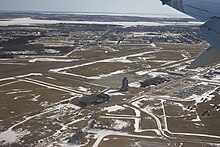History of Charlottetown
The History of Charlottetown can be traced back to the original French military settlement established on the site in 1720.
The first European settlers in the area were French; personnel from Fortress Louisbourg founded a settlement in 1720 named Port-la-Joye on the southwestern part of the harbour opposite the present-day city.
French officer Jean-Baptiste Nicolas Roch de Ramezay sent 500 men to attack the British troops in the Battle at Port-la-Joye.
British forces built Fort Amherst near the site of the abandoned Port-la-Joye settlement to protect the entrance to the harbour.
During the attack, the colonial seal was stolen and several prisoners, including Phillips Callbeck and Thomas Wright, were taken to Cambridge, Massachusetts and later released.
Named "Province House", the completion of this structure was an important milestone in the history of the capital and it is still in use today as the provincial legislature and is currently the second-oldest legislative seat in Canada.
Although many of the meetings and negotiations which would lead to Canadian Confederation were held in Province House, various social events spilled over into the surrounding community.
Aside from being the seat of colonial government, the community came to be noted during the early nineteenth century for shipbuilding and its lumber industry as well as being a fishing port.
Charlottetown's shipyards also saw extensive use during World War II, being used for refits and upgrades to numerous Royal Canadian Navy warships.
Comprehensive Development Plan in the late 1960s greatly contributed to the expansion of the provincial government in Charlottetown for the next decade.
A waterfront hotel and convention centre was completed in 1982 and helped to encourage diversification and renewal in the area, leading to several residential complexes and downtown shopping facilities.
The late 1990s and 2000s witnessed a change in the retail landscape with the opening of big box stores on the site of former traditional shopping centres and in new developments in the northern suburbs, particularly the neighbourhood of West Royalty, which is a key road junction.





